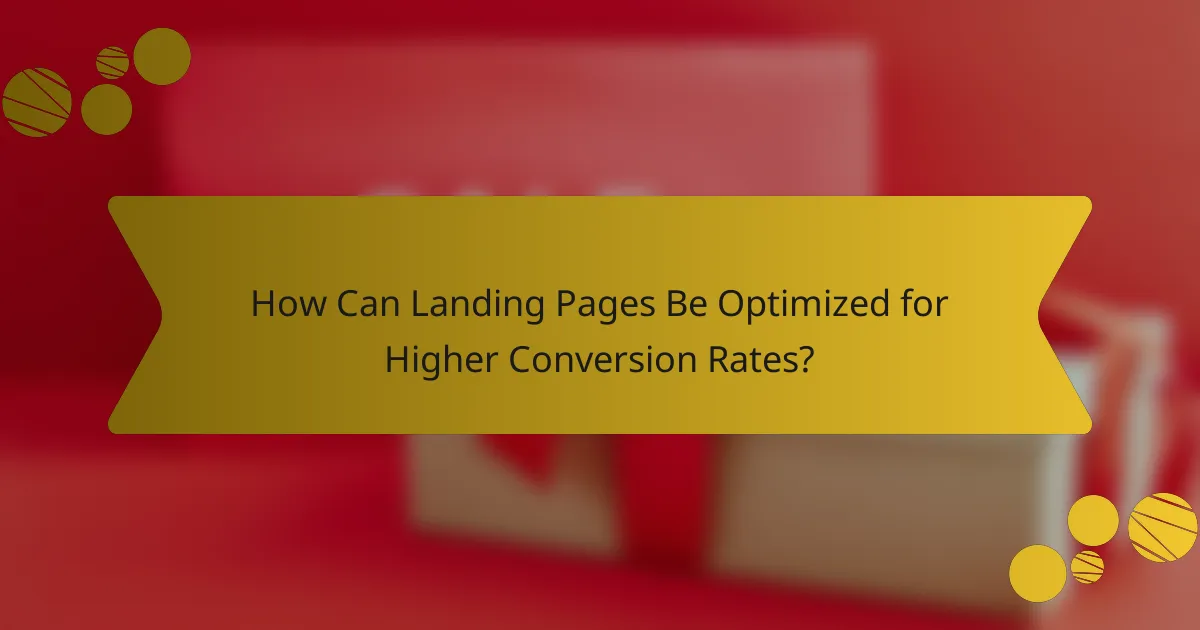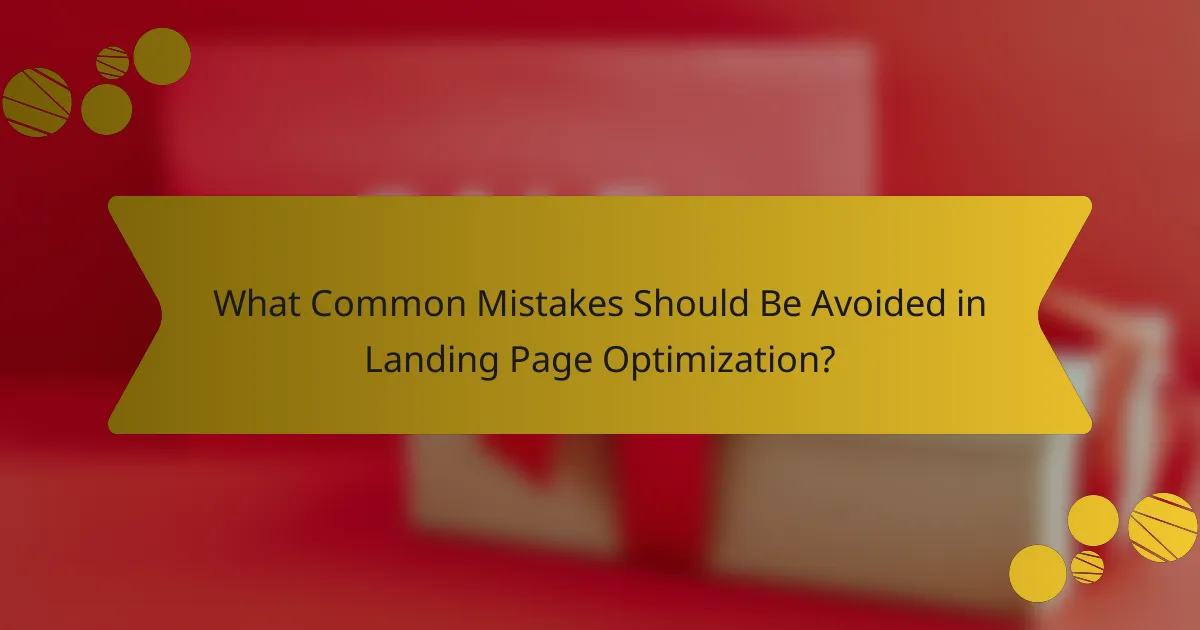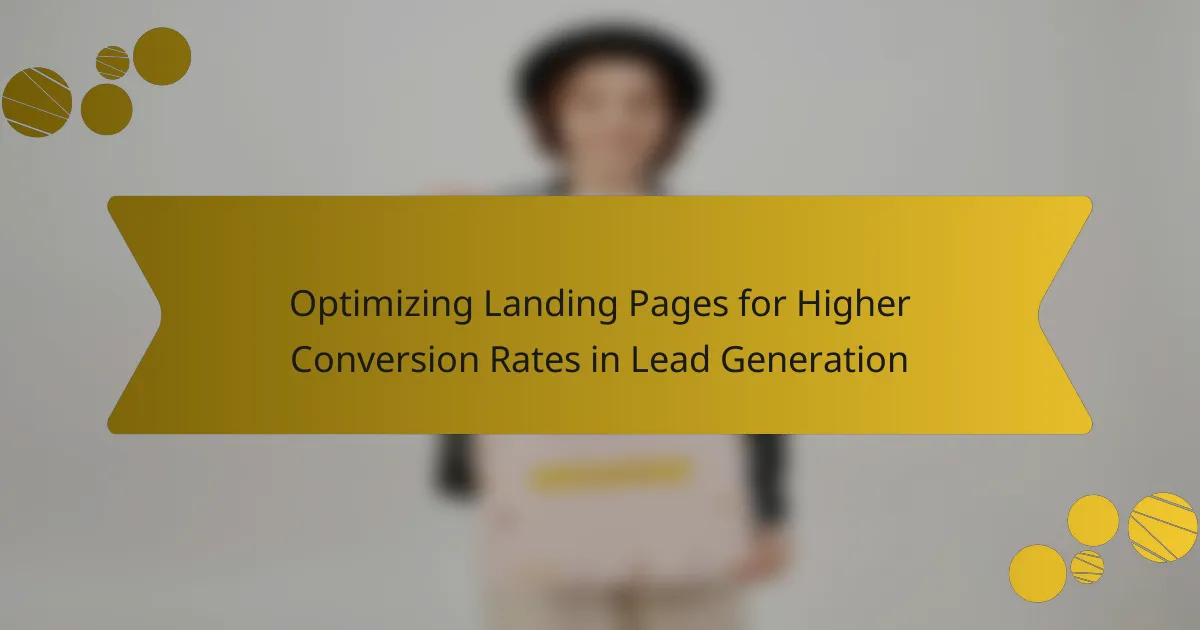Landing pages are standalone web pages specifically designed for marketing or advertising campaigns, with the primary goal of converting visitors into leads through targeted actions such as form submissions or clicks on call-to-action buttons. Their effectiveness stems from their focused design, which eliminates distractions and guides users towards a single offer, resulting in significant increases in lead generation. The article will explore essential strategies for optimizing landing pages, including crafting compelling headlines, utilizing persuasive copy, incorporating engaging visuals, and implementing strong calls-to-action. Additionally, it will address common pitfalls in landing page design and the importance of A/B testing and analytics in enhancing conversion rates.

What are Landing Pages and Their Importance in Lead Generation?
Landing pages are standalone web pages designed specifically for a marketing or advertising campaign. They serve a singular purpose: to convert visitors into leads by encouraging them to take a specific action. This action often involves filling out a form or clicking a call-to-action button.
The importance of landing pages in lead generation lies in their ability to focus the visitor’s attention on a single offer. Unlike regular web pages, landing pages eliminate distractions and guide users toward conversion. Research shows that businesses with 10 to 15 landing pages see a 55% increase in leads compared to those with fewer pages.
Effective landing pages are tailored to specific audiences and campaigns. This targeted approach enhances user experience and increases conversion rates. Overall, landing pages are essential tools for maximizing lead generation efforts.
How do landing pages differ from regular web pages?
Landing pages are designed specifically for a single conversion goal, while regular web pages serve broader purposes. Landing pages typically focus on capturing leads or driving sales through targeted content and calls to action. Regular web pages may contain various information, navigation options, and links to other pages.
Landing pages often have minimal distractions, such as fewer links or navigation menus. This design encourages visitors to complete the desired action without diversion. In contrast, regular web pages can lead users to explore multiple options, which may dilute the focus on conversion.
Additionally, landing pages are usually linked to specific marketing campaigns. They are optimized for a particular audience and message. Regular web pages are more general and may cater to a wider audience with varying interests.
Studies indicate that landing pages can achieve conversion rates of up to 25% when optimized effectively. Regular web pages often have lower conversion rates due to their broader focus and distractions.
What are the key elements that define a landing page?
A landing page is defined by several key elements that enhance its effectiveness. The primary elements include a clear and compelling headline that captures attention. A concise subheadline provides additional context and encourages further reading. Engaging visuals, such as images or videos, support the message and create interest. A strong call-to-action (CTA) prompts users to take the desired action, such as signing up or making a purchase. Additionally, social proof, like testimonials or reviews, builds trust and credibility. A simple and intuitive layout minimizes distractions and focuses the visitor on the CTA. Finally, an optimized form for lead capture is essential for gathering user information efficiently. These elements collectively contribute to a landing page’s ability to convert visitors into leads or customers.
Why are landing pages critical for lead generation?
Landing pages are critical for lead generation because they focus visitor attention on a single call-to-action. This targeted approach increases conversion rates. A well-designed landing page eliminates distractions that can lead potential customers away. According to a study by HubSpot, companies with 10 to 15 landing pages see a 55% increase in leads. Each landing page can be tailored to specific audience segments, improving relevance and engagement. Effective landing pages also enable better tracking of campaign performance. This data helps marketers refine their strategies for maximum impact. Overall, landing pages are essential tools for capturing and nurturing leads efficiently.
What factors influence the effectiveness of landing pages?
The effectiveness of landing pages is influenced by several key factors. First, the clarity of the message is crucial. A clear and concise headline can capture attention quickly. Second, the design and layout play a significant role. An aesthetically pleasing design encourages user engagement. Third, the call-to-action (CTA) must be compelling. A strong CTA can increase conversion rates significantly. Fourth, the loading speed of the page is essential. Faster loading times reduce bounce rates and improve user experience. Fifth, the relevance of content to the target audience is vital. Tailored content resonates better with visitors. Finally, social proof, such as testimonials or reviews, can enhance credibility. These factors collectively determine how effectively a landing page converts visitors into leads.
How does page design impact user engagement?
Page design significantly impacts user engagement by influencing how users interact with content. A well-structured layout enhances readability and navigation. Clear visuals guide users’ attention to essential elements. Consistent branding fosters trust and recognition. Fast loading times reduce frustration and keep users on the page. Research shows that 38% of users will stop engaging with a website if the content or layout is unattractive. Additionally, effective use of white space can improve focus on key messages. Engaging design elements, such as interactive features, can increase user participation. Overall, thoughtful page design directly correlates with higher engagement rates.
What role does copywriting play in conversion rates?
Copywriting significantly influences conversion rates by effectively communicating value to the audience. Engaging and persuasive copy captures attention and encourages action. A study by HubSpot found that compelling headlines can increase click-through rates by up to 300%. Clear calls to action guide users toward desired behaviors, enhancing the likelihood of conversion. Additionally, tailored messaging resonates with specific target audiences, increasing relevance and engagement. Effective copywriting addresses pain points and highlights benefits, leading to higher user trust and confidence. Overall, strong copywriting is essential for optimizing landing pages and improving lead generation outcomes.

How Can Landing Pages Be Optimized for Higher Conversion Rates?
Landing pages can be optimized for higher conversion rates through several effective strategies. First, ensure a clear and compelling headline that immediately captures attention. Use concise and persuasive copy that highlights benefits instead of features. Incorporate high-quality images or videos to engage visitors visually.
Additionally, implement a strong call-to-action (CTA) that stands out and prompts immediate action. Optimize the page load speed, as faster pages lead to lower bounce rates. Use A/B testing to evaluate different elements and identify what works best for your audience.
Furthermore, simplify forms by asking for only essential information to reduce friction. Display testimonials or social proof to build trust and credibility. According to research by HubSpot, pages with fewer form fields can increase conversion rates by up to 50%.
What best practices should be followed for landing page optimization?
Effective landing page optimization involves several best practices. First, ensure a clear and compelling headline. This headline should immediately convey the value proposition. Next, use concise and persuasive copy. The copy must highlight benefits and address user pain points. Incorporate strong calls to action (CTAs). These CTAs should be prominently placed and visually distinct.
Utilize high-quality images or videos. Visuals can enhance user engagement and convey messages quickly. Optimize the landing page for mobile devices. A responsive design improves accessibility and user experience. Additionally, minimize form fields. Research shows that shorter forms can lead to higher conversion rates.
A/B testing is crucial. This method allows marketers to compare different versions of the landing page. Analyzing performance data helps in making informed adjustments. Lastly, ensure fast loading times. Studies indicate that even a one-second delay can reduce conversions significantly.
How can A/B testing improve landing page performance?
A/B testing can significantly improve landing page performance by allowing marketers to compare two versions of a page. This method identifies which elements resonate better with users. By testing variations in headlines, images, or calls to action, marketers can gather data on user preferences. Studies show that A/B testing can lead to conversion rate increases of up to 300%. The process relies on statistical analysis to ensure that results are not due to chance. Implementing A/B testing helps refine strategies based on real user behavior. This leads to more effective landing pages that drive higher conversion rates.
What are the most effective call-to-action strategies?
The most effective call-to-action strategies include clear and concise messaging, compelling design, and strategic placement. Clear messaging ensures users understand what action to take. For instance, using action-oriented verbs like “Download” or “Subscribe” increases engagement. Compelling design draws attention to the CTA button. Research shows that contrasting colors can improve visibility by up to 200%. Strategic placement involves positioning CTAs above the fold and at the end of content to maximize visibility. A/B testing different variations can also identify the most effective approaches. Studies indicate that personalized CTAs can lead to a 42% higher conversion rate.
What tools are available for optimizing landing pages?
Tools available for optimizing landing pages include A/B testing software, heatmap tools, and website analytics platforms. A/B testing software, such as Optimizely or VWO, allows marketers to test different versions of landing pages. Heatmap tools like Hotjar and Crazy Egg visualize user interactions on landing pages. Website analytics platforms, including Google Analytics, provide insights into visitor behavior and conversion rates. These tools collectively help in identifying areas for improvement and enhancing user experience.
How can analytics tools enhance understanding of user behavior?
Analytics tools enhance understanding of user behavior by providing data-driven insights into user interactions. They track metrics such as page views, click-through rates, and bounce rates. This information reveals which elements of a landing page engage users effectively. For instance, Google Analytics offers real-time data on user activity. It can show which sections of a page are most visited. Heatmaps from tools like Hotjar illustrate where users click the most. These insights help identify areas for improvement. A study by HubSpot found that businesses using analytics tools saw a 20% increase in conversion rates. By analyzing user behavior, companies can optimize their landing pages for better performance.
What role does heat mapping play in optimization?
Heat mapping plays a crucial role in optimization by visually representing user interactions on a webpage. It highlights areas where users click, scroll, and hover. This data helps identify which elements engage users effectively. For example, a heat map may show that users frequently click on a specific button but ignore others. This insight allows marketers to optimize design and content for better user engagement. According to a study by Nielsen Norman Group, heat maps can increase conversion rates by up to 20% when used to refine landing pages. By focusing on user behavior, heat mapping directly informs optimization strategies aimed at improving conversion rates in lead generation.

What Common Mistakes Should Be Avoided in Landing Page Optimization?
Common mistakes to avoid in landing page optimization include poor headline choices, lack of clarity, and excessive distractions. An unclear value proposition can confuse visitors. A weak call to action may lead to lower conversion rates. Slow loading times frustrate users, causing them to leave. Not using mobile optimization can alienate a significant portion of traffic. Overloading the page with information can overwhelm visitors. Neglecting A/B testing prevents understanding what works best. Lastly, ignoring analytics means missing valuable insights for improvement.
What are the pitfalls of poor landing page design?
Poor landing page design leads to high bounce rates. Visitors quickly leave if the page is cluttered or confusing. A lack of clear calls-to-action decreases conversion opportunities. Inconsistent branding can make the company appear untrustworthy. Slow loading times frustrate users, resulting in lost leads. Mobile-unfriendly designs alienate a significant portion of users. Poorly written content fails to engage and inform visitors effectively. Lastly, inadequate testing and optimization prevent improvements based on user behavior.
How can excessive information hinder conversion rates?
Excessive information can hinder conversion rates by overwhelming potential customers. When users encounter too much information, they may feel confused or anxious. This cognitive overload can lead to decision paralysis, preventing them from taking action. Research indicates that users typically prefer concise and relevant content. A study by Nielsen Norman Group found that users often skim text and focus on key points. If a landing page is cluttered with excessive details, users may abandon it. Therefore, clarity and simplicity are crucial for effective conversion.
What are the consequences of unclear calls to action?
Unclear calls to action (CTAs) can lead to decreased conversion rates. When CTAs lack clarity, users may not understand the desired action. This confusion can result in higher bounce rates on landing pages. Research shows that clear CTAs can improve conversion rates by up to 200%. Without specific guidance, potential leads may abandon the page. A study by HubSpot found that 70% of small business websites lack a clear CTA. Consequently, unclear CTAs hinder effective lead generation efforts.
What are the key metrics to track for landing page success?
Key metrics to track for landing page success include conversion rate, bounce rate, average time on page, and click-through rate. The conversion rate measures the percentage of visitors who complete a desired action. A higher conversion rate indicates effective messaging and design. Bounce rate reflects the percentage of visitors who leave without engaging. A lower bounce rate suggests that the content resonates with the audience. Average time on page indicates how long visitors stay on the landing page. Longer durations typically indicate higher engagement. Click-through rate measures how many users click on a call-to-action. A higher click-through rate signifies effective prompts and placement. Tracking these metrics provides insights into performance and areas for improvement.
How does conversion rate impact overall marketing effectiveness?
Conversion rate directly impacts overall marketing effectiveness by measuring the percentage of visitors who take desired actions. A higher conversion rate indicates that marketing strategies effectively engage and persuade potential customers. This leads to increased sales, improved return on investment (ROI), and enhanced customer acquisition. According to a study by HubSpot, businesses with higher conversion rates often see a significant increase in revenue. Additionally, optimizing landing pages to improve conversion rates can enhance user experience, leading to greater customer satisfaction and loyalty. Therefore, conversion rates serve as a critical metric for evaluating and refining marketing efforts.
What other KPIs should be monitored alongside conversion rates?
Other KPIs that should be monitored alongside conversion rates include bounce rate, average session duration, and click-through rate. Bounce rate indicates the percentage of visitors who leave the site after viewing only one page. A high bounce rate may suggest that the landing page is not engaging enough. Average session duration measures how long visitors stay on the site. Longer sessions often correlate with higher engagement and potential conversions. Click-through rate tracks the percentage of users who click on a specific link or call to action. A low click-through rate may indicate that the content is not compelling enough. Monitoring these KPIs provides a broader understanding of user behavior and landing page effectiveness.
What practical tips can improve landing page performance?
To improve landing page performance, focus on clear and compelling headlines. Research shows that 80% of visitors only read headlines. Ensure your call-to-action (CTA) is prominent and actionable. A/B testing different CTAs can boost conversions by 20%. Optimize page load speed, as a delay of even one second can reduce conversions by 7%. Use high-quality images and videos to engage users; content with visuals gets 94% more views. Ensure mobile optimization, as 50% of web traffic comes from mobile devices. Simplify forms to increase completion rates; forms with fewer fields can lead to a 120% increase in submissions. Include social proof, such as testimonials, to build trust; 70% of consumers trust reviews from others.
The main entity of the article is landing pages, which are specialized web pages designed to convert visitors into leads through focused calls to action. The article outlines the critical role of landing pages in lead generation, emphasizing their ability to minimize distractions and enhance user experience. Key elements for effective landing pages, factors influencing their performance, and strategies for optimization are discussed, including the importance of clear messaging, compelling design, and A/B testing. Additionally, the article highlights common mistakes to avoid and key metrics to track for measuring success, providing practical tips for improving landing page performance and conversion rates.
